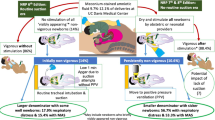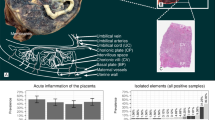Abstract
Objective
The objective of this study is to compare pregnancy outcomes in deliveries complicated by primary meconium-stained amniotic fluid (MSAF, present at membrane rupture) and secondary MSAF (transitioned from clear to MSAF during labor).
Methods
The medical records and neonatal charts of all deliveries ≥ 370/7 weeks between October 2008 and July 2018 were reviewed. The primary outcome was composite adverse neonatal outcome that included early neonatal complications.
Results
Of 30,215 deliveries during the study period, 4302 (14.2 %) were included: 3845 (89.4%) in the primary MSAF group and 457 (10.6%) in the secondary MSAF group. The rate of the primary outcome was higher in the secondary MSAF group (p = 0.006). This association remained significant after controlling for background confounders. The secondary MSAF group had higher rate of cesarean deliveries (CDs) and assisted vaginal deliveries. There was a higher rate of composite adverse neonatal outcome when secondary MSAF was diagnosed < 3 vs. >3 h before delivery (p = 0.004).
Conclusion
Secondary MSAF was associated with higher rates of adverse neonatal outcome, CDs, and assisted vaginal deliveries, compared with primary MSAF.
This is a preview of subscription content, access via your institution
Access options
Subscribe to this journal
Receive 12 print issues and online access
$259.00 per year
only $21.58 per issue
Buy this article
- Purchase on Springer Link
- Instant access to full article PDF
Prices may be subject to local taxes which are calculated during checkout

Similar content being viewed by others
References
Whitfield JM, Charsha DS, Chiruvolu A. Prevention of meconium aspiration syndrome: an update and the Baylor experience. Proc (Bayl Univ Med Cent). 2009;22:128–31. https://doi.org/10.1080/08998280.2009.11928491
David AN, Njokanma OF, Iroha E. Incidence of and factors associated with meconium staining of the amniotic fluid in a Nigerian University Teaching Hospital. J Obstet Gynaecol (Lahore). 2006;26:518–20. https://doi.org/10.1080/01443610600797426
Balchin I, Whittaker JC, Lamont RF, Steer PJ. Maternal and fetal characteristics associated with meconium-stained amniotic fluid. Obstet Gynecol. 2011;117:828–35. https://doi.org/10.1097/AOG.0b013e3182117a26
Addisu D, Asres A, Gedefaw G, Asmer S. Prevalence of meconium stained amniotic fluid and its associated factors among women who gave birth at term in Felege Hiwot comprehensive specialized referral hospital, North West Ethiopia: a facility based cross-sectional study. BMC Pregnancy Childbirth. 2018;18:429. https://doi.org/10.1186/s12884-018-2056-y
Hiersch L, Krispin E, Aviram A, Wiznitzer A, Yogev Y, Ashwal E. Effect of meconium-stained amniotic fluid on perinatal complications in low-risk pregnancies at term. Am J Perinatol. 2016;33:378–84. https://doi.org/10.1055/s-0035-1565989
Ziadeh SM, Sunna E. Obstetric and perinatal outcome of pregnancies with term labour and meconium-stained amniotic fluid. Arch Gynecol Obstet. 2000;264:84–7. https://doi.org/10.1007/s004040000088
Maymon E, Chaim W, Furman B, Ghezzi F, Shoham Vardi I, Mazor M. Meconium stained amniotic fluid in very low risk pregnancies at term gestation. Eur J Obstet Gynecol Reprod Biol 1998. https://doi.org/10.1016/S0301-2115(98)00122-5
American College of Obstetricians and Gynecologists Women’s Health Care Physicians (ACOG). ACOG Practice Bulletin No. 138. Inherited thrombophilias in pregnancy. Obstet Gynecol. 2013;122:706–17. https://doi.org/10.1097/01.AOG.0000433981.36184.4e
Committee on Practice Bulletins—Obstetrics, American College of Obstetricians and Gynecologists. Practice Bulletin No. 132: Antiphospholipid syndrome. Obstet Gynecol. 2012;120:1514–21. https://doi.org/10.1097/01.AOG.0000423816.39542.0f
American College of Obstetricians and Gynecologists. ACOG Practice Bulletin No. 101: Ultrasonography in pregnancy. Obstet Gynecol. 2009;113:451–61. https://doi.org/10.1097/AOG.0b013e31819930b0
Expert Committee on the Diagnosis and Classification of Diabetes Mellitus. Report of the expert committee on the diagnosis and classificatin of diabetes mellitus. Diabetes Care. 2002;26:S5–20. https://doi.org/10.2337/diacare.25.2007.S5
American College of Obstetricians and Gynecologists, Task Force on Hypertension in Pregnancy. Hypertension in pregnancy. Report of the American College of Obstetricians and Gynecologists’ Task Force on Hypertension in Pregnancy. Obstet Gynecol. 2013;122:1122–31. https://doi.org/10.1097/01.AOG.0000437382.03963.88
Kehl S, Schelkle A, Thomas A, Puhl A, Meqdad K, Tuschy B, et al. Single deepest vertical pocket or amniotic fluid index as evaluation test for predicting adverse pregnancy outcome (SAFE trial): a multicenter, open-label, randomized controlled trial. Ultrasound Obstet Gynecol. 2016;47:674–9. https://doi.org/10.1002/uog.14924
Dollberg S, Haklai Z, Mimouni FB, Gorfein I, Gordon ES. Birthweight standards in the live-born population in Israel. Isr Med Assoc J. 2005;7:311–4. https://doi.org/10.3389/fped.2015.00063
Tita ATN, Andrews WW. Diagnosis and management of clinical chorioamnionitis. Clin Perinatol. 2010;37:339–54. https://doi.org/10.1016/j.clp.2010.02.003
Ciftci AO, Tanyel FC, Ercan MT, Karnak I, Büyükpamukçu N, Hiçsönmez A. In utero defecation by the normal fetus: a radionuclide study in the rabbit. J Pediatr Surg. 1996;31:1409–12. https://doi.org/10.1016/S0022-3468(96)90841-6
Meis PJ, Hall M, Marshall JR, Hobel CJ. Meconium passage: A new classification for risk assessment during labor. Am J Obstet Gynecol. 1978;131:509–13. https://doi.org/10.1016/0002-9378(78)90111-4
Hiersch L, Melamed N, Rosen H, Peled Y, Wiznitzer A, Yogev Y. New onset of meconium during labor versus primary meconium-stained amniotic fluid - Is there a difference in pregnancy outcome? J Matern Neonatal Med. 2014;27:1361–7. https://doi.org/10.3109/14767058.2013.858320
Locatelli A, Regalia AL, Patregnani C, Ratti M, Toso L, Ghidini A. Prognostic value of change in amniotic fluid color during labor. Fetal Diagn Ther. 2005:20:5–9. https://doi.org/10.1159/000081359
Meis PJ, Hobel CJ, Ureda JR. Late meconium passage in labor - A sign of fetal distress? Obstet Gynecol. 1982;59:332–5.
Gluck O, Kovo M, Tairy D, Barda G, Bar J, Weiner E. Bloody amniotic fluid during labor – prevalence, and association with placental abruption, neonatal morbidity, and adverse pregnancy outcomes. Eur J Obstet Gynecol Reprod Biol 2019;234(October 2008):103–7. https://doi.org/10.1016/j.ejogrb.2019.01.011
Weiner E, Schreiber L, Grinstein E, Feldstein O, Rymer-Haskel N, Bar J, et al. The placental component and obstetric outcome in severe preeclampsia with and without HELLP syndrome. Placenta. 2016;47:99–104. https://doi.org/10.1016/j.placenta.2016.09.012
Weiner E, Miremberg H, Grinstein E, Mizrachi Y, Schreiber L, Bar J, et al. The effect of placenta previa on fetal growth and pregnancy outcome, in correlation with placental pathology. J Perinatol. 2016;36:1073–78. https://doi.org/10.1038/jp.2016.140
Acknowledgements
We thank Meir Azran, Computing and Information Systems, E. Wolfson Medical Center, Holon, Israel, and Ela Smirin, archive, E. Wolfson Medical Center, Holon, Israel.
Author information
Authors and Affiliations
Corresponding author
Ethics declarations
Conflict of interest
The authors declare that they have no conflict of interest.
Additional information
Publisher’s note: Springer Nature remains neutral with regard to jurisdictional claims in published maps and institutional affiliations.
Rights and permissions
About this article
Cite this article
Tairy, D., Gluck, O., Tal, O. et al. Amniotic fluid transitioning from clear to meconium stained during labor—prevalence and association with adverse maternal and neonatal outcomes. J Perinatol 39, 1349–1355 (2019). https://doi.org/10.1038/s41372-019-0436-4
Received:
Revised:
Accepted:
Published:
Issue Date:
DOI: https://doi.org/10.1038/s41372-019-0436-4



